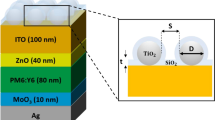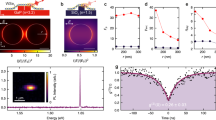Abstract
Elaborating reliable and versatile strategies for efficient light coupling between free space and thin films is of crucial importance for new technologies in energy efficiency. Nanostructured materials have opened unprecedented opportunities for light management, notably in thin-film solar cells1,2. Efficient coherent light trapping has been accomplished through the careful design of plasmonic nanoparticles and gratings3,4, resonant dielectric particles5,6 and photonic crystals7,8,9,10. Alternative approaches have used randomly textured surfaces11,12,13 as strong light diffusers to benefit from their broadband and wide-angle properties. Here, we propose a new strategy for photon management in thin films that combines both advantages of an efficient trapping due to coherent optical effects and broadband/wide-angle properties due to disorder. Our approach consists of the excitation of electromagnetic modes formed by multiple light scattering and wave interference in two-dimensional random media. We show, by numerical calculations, that the spectral and angular responses of thin films containing disordered photonic patterns are intimately related to the in-plane light transport process and can be tuned through structural correlations. Our findings, which are applicable to all waves, are particularly suited for improving the absorption efficiency of thin-film solar cells and can provide a new approach for high-extraction-efficiency light-emitting diodes.
This is a preview of subscription content, access via your institution
Access options
Subscribe to this journal
Receive 12 print issues and online access
$259.00 per year
only $21.58 per issue
Buy this article
- Purchase on Springer Link
- Instant access to full article PDF
Prices may be subject to local taxes which are calculated during checkout



Similar content being viewed by others
References
Polman, A. & Atwater, H. A. Photonic design principles for ultrahigh-efficiency photovoltaics. Nature Mater. 11, 174–177 (2012).
Mallick, S. B., Sergeant, N. P., Agrawal, M., Lee, J-Y. & Peumans, P. Coherent light trapping in thin-film photovoltaics. Mater. Res. Soc. Bull. 36, 453–460 (2011).
Atwater, H. A. & Polman, A. Plasmonics for improved photovoltaic devices. Nature Mater. 9, 205–213 (2010).
Pillai, S. & Green, M. A. Plasmonics for photovoltaic applications. Sol. Energy Mater. Sol. Cells 94, 1481–1486 (2010).
Yao, Y. et al. Broadband light management using low-Q whispering gallery modes in spherical nanoshells. Nature Commun. 3, 664 (2012).
Spinelli, P., Verschuuren, M. & Polman, A. Broadband omnidirectional antireflection coating based on subwavelength surface Mie resonators. Nature Commun. 3, 692 (2012).
Meng, X. et al. Absorbing photonic crystals for silicon thin-film solar cells: Design, fabrication and experimental investigation. Sol. Energy Mater. Sol. Cells 95, S32–S38 (2011).
Battaglia, C. et al. Nanomoulding of transparent zinc oxide electrodes for efficient light trapping in solar cells. Nature Photon. 5, 535–538 (2011).
Mallick, S. B. et al. Ultrathin crystalline–silicon solar cells with embedded photonic crystals. Appl. Phys. Lett. 100, 053113 (2012).
Bozzola, A., Liscidini, M. & Andreani, L. C. Photonic light-trapping versus Lambertian limits in thin film silicon solar cells with 1d and 2d periodic patterns. Opt. Express 20, A224–A244 (2012).
Rockstuhl, C. et al. Comparison and optimization of randomly textured surfaces in thin-film solar cells. Opt. Express 18, A335–A341 (2010).
Ferry, V. E. et al. Optimized spatial correlations for broadband light trapping nanopatterns in high efficiency ultrathin film a-Si:H solar cells. Nano Lett. 11, 4239–4245 (2011).
Sheng, X., Johnson, S. G., Michel, J. & Kimerling, L. C. Optimization-based design of surface textures for thin-film Si solar cells. Opt. Express 19, A841–A850 (2011).
Akkermans, E. & Montambaux, G. Mesoscopic Physics of Electrons and Photons 1st edn (Cambridge Univ. Press, 2007).
Lye, J. E. et al. Bose–Einstein condensate in a random potential. Phys. Rev. Lett. 95, 070401 (2005).
Aspect, A. & Inguscio, M. Anderson localization of ultracold atoms. Phys. Today 62, 30–35 (August, 2009).
Sheng, P. Introduction to Wave Scattering, Localization and Mesoscopic Phenomena 2nd edn (Springer, 2010).
Wang, J. & Genack, A. Z. Transport through modes in random media. Nature 471, 345–348 (2011).
Sebbah, P., Sornette, D. & Vanneste, C. Anomalous diffusion in two-dimensional Anderson-localization dynamics. Phys. Rev. B 48, 12506–12510 (1993).
Sigalas, M. M., Soukoulis, C. M., Chan, C-T. & Turner, D. Localization of electromagnetic waves in two-dimensional disordered systems. Phys. Rev. B 53, 8340–8348 (1996).
Schwartz, T., Bartal, G., Fishman, S. & Segev, M. Transport and Anderson localization in disordered two-dimensional photonic lattices. Nature 446, 52–55 (2007).
Riboli, F. et al. Anderson localization of near-visible light in two dimensions. Opt. Lett. 36, 127–129 (2011).
Vollhardt, D. & Wölfle, P. Diagrammatic, self-consistent treatment of the Anderson localization problem in d<2 dimensions. Phys. Rev. B 22, 4666–4679 (1980).
Sebbah, P. & Vanneste, C. Random laser in the localized regime. Phys. Rev. B 66, 144202 (2002).
Noh, H. et al. Control of lasing in biomimetic structures with short-range order. Phys. Rev. Lett. 106, 183901 (2011).
Brown, G. & Wu, J. Third generation photovoltaics. Laser Photon. Rev. 3, 394–405 (2009).
Schnitzer, I., Yablonovitch, E., Caneau, C., Gmitter, T. J. & Scherer, A. 30% external quantum efficiency from surface textured, thin film light emitting diodes. Appl. Phys. Lett. 63, 2174–2176 (1993).
Wiesmann, C., Bergenek, K., Linder, N. & Schwarz, U. Photonic crystal LEDs–designing light extraction. Laser Photon. Rev. 3, 262–286 (2009).
Yablonovitch, E. & Cody, G. D. Intensity enhancement in textured optical sheets for solar cells. IEEE Trans. Electron Dev. 29, 300–305 (1982).
Green, M. A. Lambertian light trapping in textured solar cells and light- emitting diodes: analytical solutions. Prog. Photovol.: Res. Appl. 10, 235–241 (2002).
Taflove, A. & Hagness, S. C. Computational Electrodynamics: The Finite-Difference Time-Domain Method 3rd edn (Artech House, 2005).
Palik, E. D. Handbook of Optical Constants of Solids (Academic, 1997).
Yu, Z., Raman, A. & Fan, S. Fundamental limit of nanophotonic light trapping in solar cells. Proc. Natl Acad. Sci. USA 107, 17491–17496 (2010).
Callahan, D. M., Munday, J. N. & Atwater, H. A. Solar cell light trapping beyond the ray optic limit. Nano Lett. 12, 214–218 (2012).
Lagendijk, A. & van Tiggelen, B. A. Resonant multiple scattering of light. Phys. Rep. 270, 143–215 (1996).
Engelen, R. J. P. et al. Ultrafast evolution of photonic eigenstates in k-space. Nature Phys. 3, 401–405 (2007).
Burresi, M., van Oosten, D., Song, B. S., Noda, S. & Kuipers, L. Ultrafast reciprocal space investigation of cavity–waveguide coupling. Opt. Lett. 36, 1827–1829 (2011).
Rojas-Ochoa, L. F., Mendez-Alcaraz, J. M., Sáenz, J. J., Schurtenberger, P. & Scheffold, F. Photonic properties of strongly correlated colloidal liquids. Phys. Rev. Lett. 93, 073903 (2004).
Florescu, M., Torquato, S. & Steinhardt, P. J. Designer disordered materials with large, complete photonic band gaps. Proc. Natl Acad. Sci. USA 106, 20658–20663 (2009).
Yang, J. et al. Photonic-band-gap effects in two-dimensional polycrystalline and amorphous structures. Phys. Rev. A 82, 053838 (2010).
Joannopoulos, J. D., Johnson, S. G., Winn, J. N. & Meade, R. D. Photonic Crystals: Molding the Flow of Light 2nd edn (Princeton Univ. Press, 2008).
Skoge, M., Donev, A., Stillinger, F. H. & Torquato, S. Packing hyperspheres in high-dimensional Euclidean spaces. Phys. Rev. E 74, 041127 (2006).
Hammer, M. 1-D multilayer slab waveguide mode solver. http://www.home.math.utwente.nl/~hammer/oms.html.
Oskooi, A. F. et al. Meep: A flexible free-software package for electromagnetic simulations by the FDTD method. Comput. Phys. Commun. 181, 687–702 (2010).
Acknowledgements
This work is supported by the Eu NoE Nanophotonics for Energy Efficiency, the Italian CNR project EFOR and ENI S.p.A. We gratefully acknowledge P. Barthelemy, J. Bertolotti and T. Svensson for insightful discussions.
Author information
Authors and Affiliations
Contributions
All authors developed the concept. K.V. carried out the numerical simulations. K.V. and M.B. performed the data analysis. All authors discussed and interpreted the results. K.V. prepared the manuscript with suggestions from M.B., F.R. and D.S.W.
Corresponding author
Ethics declarations
Competing interests
The authors declare no competing financial interests.
Supplementary information
Supplementary Information
Supplementary Information (PDF 487 kb)
Rights and permissions
About this article
Cite this article
Vynck, K., Burresi, M., Riboli, F. et al. Photon management in two-dimensional disordered media. Nature Mater 11, 1017–1022 (2012). https://doi.org/10.1038/nmat3442
Received:
Accepted:
Published:
Issue Date:
DOI: https://doi.org/10.1038/nmat3442
This article is cited by
-
All-optical multilevel physical unclonable functions
Nature Materials (2024)
-
Isotropic gap formation, localization, and waveguiding in mesoscale Yukawa-potential amorphous structures
Communications Physics (2024)
-
Optical Response of a Composite System “Monolayer of Spherical Particles in an Absorbing Matrix” at Normal Incidence of Plane Wave
Journal of Applied Spectroscopy (2023)
-
Efficiency Enhancement in Dye Sensitized Solar Cell Using 1D Photonic Crystal
Silicon (2022)
-
Zinc sulfide quantum dots coated with PVP: applications on commercial solar cells
Journal of Materials Science: Materials in Electronics (2021)



